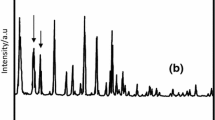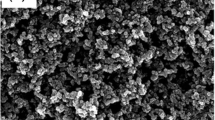Abstract
The reactivity of cobalt(II) complexes with molecular oxygen is a heavily studied and extremely important catalytic system. These interactions result in the formation of metal-dioxygen adducts that are responsible for numerous cobalt-catalyzed oxidations. In the case of 4-coordinate cobalt salen [Co(salen)] complexes, the formation of catalytically active, mononuclear, superoxo adducts in the presence of a secondary, N-donor ligand has been demonstrated [Co(salen)pyr-O2]. In batch reactions, these adducts are known to readily oxidize certain para-substituted phenolic compounds resulting in benzoquinones in high yield. Para-phenolic model compounds have been used to demonstrate the potential use of cobalt Schiff base complexes in the oxidation of lignin biomass. This work investigates the redox behavior of the Co(salen)pyr-O2 adduct as a potential recyclable electrocatalyst. Using traditional electrochemical techniques, the activity of the Co(salen)pyr-O2 adduct is evaluated as it applies to the oxidation of the substrate syringyl alcohol (4-(hydroxymethyl)-2,6-dimethoxy-phenol) in acetonitrile. Typical EC′ electrochemical behavior is reported showing a near linear relationship between substrate concentration and peak current density (Jp) up to 200 mV s−1. Electrochemical titration of catalytic amounts of Co(salen) with pyridine in the presence of excess oxygen and substrate indicate that the one-electron oxidation of Co(salen)pyr-O2H is reversible up to 2:1 pyridine to cobalt. However EPR characterization of electrolysis experiments with Co(salen)pyr-O2 in the presence of excess substrate show evidence for the deactivation of the catalyst system after two hours, indicating possible poor ligand stability or the occurrence of an inhibiting side reaction under reaction conditions.
Graphic abstract














Similar content being viewed by others
Data availability
Data and materials are freely available upon request via the email provided.
References
Calvo-Flores FG, Dobado JA (2010) Lignin as renewable raw material. ChemSusChem 3:1227–1235. https://doi.org/10.1002/cssc.201000157
Laurichesse S, Avérous L (2014) Chemical modification of lignins: towards biobased polymers. Prog Polym Sci 39:1266–1290. https://doi.org/10.1016/j.progpolymsci.2013.11.004
Zakzeski J, Bruijnincx PCA, Jongerius AL, Weckhuysen BM (2010) The catalytic valorization of lignin for the production of renewable chemicals. Chem Rev 110:3552–3599. https://doi.org/10.1021/cr900354u
Küçük MM (2005) Delignification of biomass using alkaline glycerol. Energy Sources 27:1245–1255. https://doi.org/10.1080/009083190519375
McKendry P (2002) Energy production from biomass (part 1): overview of biomass. Bioresour Technol 83:37–46. https://doi.org/10.1016/S0960-8524(01)00118-3
Muradov NZ, Veziroǧlu TN (2008) “Green” path from fossil-based to hydrogen economy: an overview of carbon-neutral technologies. Int J Hydrogen Energy 33:6804–6839. https://doi.org/10.1016/j.ijhydene.2008.08.054
Wilkerson CG, Mansfield SD, Lu F et al (2014) Monolignol ferulate transferase introduces chemically labile linkages into the lignin backbone. Science 344:90–93. https://doi.org/10.1126/science.1250161
Zombeck A, Drago RS, Corden BB, Gaul JH (1981) Activation of molecular oxygen. Mechanistic studies of the oxidation of hindered phenols with cobalt-dioxygen complexes. J Am Chem Soc 103:7580–7585. https://doi.org/10.1021/ja00415a027
Tejado A, Peña C, Labidi J et al (2007) Physico-chemical characterization of lignins from different sources for use in phenol-formaldehyde resin synthesis. Bioresour Technol 98:1655–1663. https://doi.org/10.1016/j.biortech.2006.05.042
Han Y, Yuan L, Li G et al (2016) Renewable polymers from lignin via copper-free thermal click chemistry. Polymer 83:92–100. https://doi.org/10.1016/j.polymer.2015.12.010
Uihlein A, Schebek L (2009) Environmental impacts of a lignocellulose feedstock biorefinery system: An assessment. Biomass Bioenergy 33:793–802. https://doi.org/10.1016/j.biombioe.2008.12.001
Luterbacher JS, Martin Alonso D, Dumesic JA (2014) Targeted chemical upgrading of lignocellulosic biomass to platform molecules. Green Chem 16:4816–4838. https://doi.org/10.1039/C4GC01160K
Upton BM, Kasko AM (2016) Strategies for the Conversion of Lignin to High-Value Polymeric Materials: Review and Perspective. Chem Rev 116:2275–2306. https://doi.org/10.1021/acs.chemrev.5b00345
Bozell JJ, Hames BR, Dimmel DR (1995) Cobalt-schiff base complex catalyzed oxidation of para-substituted phenolics. Preparation of benzoquinones. J Org Chem 60:2398–2404. https://doi.org/10.1021/jo00113a020
Cozzi PG (2004) Metal-Salen Schiff base complexes in catalysis: practical aspects. Chem Soc Rev 33:410–421. https://doi.org/10.1039/b307853c
Li CZ, Nishiyama K, Taniguchi I (2000) Electrochemical and spectroelectrochemical studies on cobalt myoglobin. Electrochim Acta 45:2883–2888. https://doi.org/10.1016/S0013-4686(00)00363-7
Jones RD, Summerville DA, Basolo F (1979) Synthetic oxygen carriers related to biological systems. Chem Rev 79:139–179. https://doi.org/10.1021/cr60318a002
Khandar AA, Shaabani B, Belaj F, Bakhtiari A (2006) Synthesis, characterization and spectroscopic and electrochemical studies of new axially coordinated cobalt(III) salen (salen = N,N′-bis(salicylidene)-1,2-ethylenediamine) complexes. The crystal structure of [CoIII(salen)(aniline)2]ClO4. Polyhedron 25:1893–1900. https://doi.org/10.1016/j.poly.2005.12.001
Kapturkiewicz A, Behr B (1983) Voltammetric studies of Co(salen) and Ni(salen) in nonaqueous solvents at Pt electrode. Inorg Chim Acta 69:247–251. https://doi.org/10.1016/S0020-1693(00)83581-1
Pavlishchuk VV, Addison AW (2000) Conversion constants for redox potentials measured versus different reference electrodes in acetonitrile solutions at 25 °C. Inorg Chim Acta 298:97–102. https://doi.org/10.1016/S0020-1693(99)00407-7
Bond AM, Oldham KB, Snook GA (2000) Use of the ferrocene oxidation process to provide both reference electrode potential calibration and a simple measurement (via semiintegration) of the uncompensated resistance in cyclic voltammetric studies in high-resistence organic solvents. Anal Chem 72:3492–3496. https://doi.org/10.1021/ac000020j
Laviron E (1979) General expression of the linear potential sweep voltammogram in the case of diffusionless electrochemical systems. J Electroanal Chem 101:19–28. https://doi.org/10.1016/S0022-0728(79)80075-3
Xie Y, Anson FC (1995) Analysis of the cyclic voltammetric responses exhibited by electrodes modified with monolayers of catalysts in the absence and presence of substrates. J Electroanal Chem 384:145–153. https://doi.org/10.1016/0022-0728(94)03746-p
Dalton EF, Surridge NA, Jernigan JC et al (1990) Charge transport in electroactive polymers consisting of fixed molecular redox sites. Chem Phys 141:143–157. https://doi.org/10.1016/0301-0104(90)80026-T
Gowda JI, Nandibewoor ST (2015) Carbon paste sensor for the determination of an anticancer drug paclitaxel in pharmaceuticals and biological fluids. Anal Bioanal Electrochem 7:539–554
Zare HR, Chatraei F, Nasirizadeh N (2010) Differential pulse voltammetric determination of hydroxylamine at an indenedione derivative electrodeposited on a multi-wall carbon nanotube modified glassy carbon electrode. J Braz Chem Soc 21:1977–1985. https://doi.org/10.1590/S0103-50532010001000025
Kervinen K, Korpi H, Leskelä M, Repo T (2003) Oxidation of veratryl alcohol by molecular oxygen in aqueous solution catalyzed by cobalt salen-type complexes: the effect of reaction conditions. J Mol Catal A Chem 203:9–19. https://doi.org/10.1016/S1381-1169(03)00156-0
Díaz-González M, Vidal T, Tzanov T (2011) Phenolic compounds as enhancers in enzymatic and electrochemical oxidation of veratryl alcohol and lignins. Appl Microbiol Biotechnol 89:1693–1700. https://doi.org/10.1007/s00253-010-3007-3
Caldwell ES, Steelink C (1969) Phenoxy radical intermediate in the enzymatic degradation of lignin model compounds. BBA - Gen Subj 184:420–431. https://doi.org/10.1016/0304-4165(69)90046-4
Rajendran L, Sangaranarayanan MV (1999) Diffusion at ultramicro disk electrodes: chronoamperometric current for steady-state EC′ reaction using scattering analogue techniques. J Phys Chem B 103:1518–1524. https://doi.org/10.1021/jp983384c
Rountree ES, McCarthy BD, Eisenhart TT, Dempsey JL (2014) Evaluation of homogeneous electrocatalysts by cyclic voltammetry. Inorg Chem 53:9983–10002. https://doi.org/10.1021/ic500658x
Savéant JM (2008) Molecular catalysis of electrochemical reactions. Mechanistic aspects. Chem Rev 108:2348–2378. https://doi.org/10.1021/cr068079z
Costentin C, Drouet S, Robert M, Savéant JM (2012) Turnover numbers, turnover frequencies, and overpotential in molecular catalysis of electrochemical reactions. Cyclic voltammetry and preparative-scale electrolysis. J Am Chem Soc 134:11235–11242. https://doi.org/10.1021/ja303560c
Savéant JM (2018) Molecular catalysis of electrochemical reactions. Cyclic voltammetry of systems approaching reversibility. ACS Catal 8:7608–7611. https://doi.org/10.1021/acscatal.8b02007
Rieppo L, Saarakkala S, Närhi T et al (2012) Application of second derivative spectroscopy for increasing molecular specificity of fourier transform infrared spectroscopic imaging of articular cartilage. Osteoarthr Cartil 20:451–459. https://doi.org/10.1016/j.joca.2012.01.010
Hitchman MA (1977) Electronic structure of low-spin cobalt(II) Schiff base complexes. Inorg Chem 16:1985–1993. https://doi.org/10.1021/ic50174a032
Ghosh P, Taube H, Hasegawa T, Kuroda R (1995) Vanadium(II) salts in pyridine and acetonitrile solvents. Inorg Chem 34:5761–5775. https://doi.org/10.1021/ic00127a013
Rudie AW, Hart PW (2014) Catalysis: A potential alternative to kraft pulping. A synthesis of the literature. In: Proceedings of the PEERS Conference, 2014, pp 33–46
Hall MB (1988) Bonding of dioxygen to transition metals. Oxygen complexes and oxygen activation by transition metals. Springer, New York, pp 3–16
Smith TD, Pilbrow JR (1981) Recent developments in the stidies of molecular oxygen adducts of cobalt (II) compounds and related systems. Coord Chem Rev 39:295–383. https://doi.org/10.1016/S0010-8545(00)82006-8
Huber A, Müller L, Elias H et al (2005) Cobalt(II) complexes with substituted salen-type ligands and their dioxygen affinity in N,N-dimethylformamide at various temperatures. Eur J Inorg Chem 2005:1459–1467. https://doi.org/10.1002/ejic.200400888
Myers WK, Duesler EN, Tierney DL (2008) Integrated paramagnetic resonance of high-spin Co(II) in axial symmetry: chemical separation of dipolar and contact electron-nuclear couplings. Inorg Chem 47:6701–6710. https://doi.org/10.1021/ic800245k
Zarembowitch J, Kahn O (1984) Magnetic properties of some spin-crossover, high-spin, and low-spin cobalt(II) complexes with Schiff bases derived from 3-formylsalicylic acid. Inorg Chem 23:589–593. https://doi.org/10.1021/ic00173a020
Nishida Y, Kida S (1978) Ground states of the square planar low-spin cobalt(II) complexes. Bull Chem Soc Jpn 51:143–149. https://doi.org/10.1246/bcsj.51.143
Nishida Y, Kida S (1979) Splitting of d-orbitals in square planar complexes of copper(II), nickel(II) and cobalt(II). Coord Chem Rev 27:275–298. https://doi.org/10.1016/S0010-8545(00)82069-X
Meek DW, Drago RS, Piper TS (1962) Spectrochemical studies of dimethyl sulfoxide, tetramethylene sulfoxide, and pyridine N-oxide as ligands with nickel(II), chromium(III), and cobalt(II). Inorg Chem 1:285–289. https://doi.org/10.1021/ic50002a017
Drago RS, Meek DW, Joesten MD, Laroche L (1963) Spectrochemical studies of a series of amides as ligands with nickel(II) and chromium(III). Inorg Chem 2:124–127. https://doi.org/10.1021/ic50005a032
Cockle SA (1974) Electron paramagnetic resonance studies on cobalt(II) carbonic anhydrase. Low spin cyanide complexes. Biochem J 137:587–596. https://doi.org/10.1042/bj1370587
Böttcher A, Elias H, Jäger EG et al (1993) Comparative study on the coordination chemistry of cobalt(II), nickel(II), and copper(II) with derivatives of salen and tetrahydrosalen: metal-catalyzed oxidative dehydrogenation of the C-N bond in coordinated tetrahydrosalen. Inorg Chem 32:4131–4138. https://doi.org/10.1021/ic00071a028
Cockle SA, Hill HAO, Williams RJP (1970) The formation of some superoxo-cobalt(III) complexes: an investigation by E.P.R. spectroscopy. Inorg Nucl Chem Lett 6:131–134. https://doi.org/10.1016/0020-1650(70)80326-9
Bolzacchini E, Canevali C, Morazzoni F et al (1997) Spectromagnetic investigation of the active species in the oxidation of propenoidic phenols catalysed by [N, N′-bis(salicylidene)-ethane-1,2-diaminato]cobalt(II). J Chem Soc - Dalt Trans. https://doi.org/10.1039/a705188c
Jain S, Zheng X, Jones CW, et al (2007) Importance of counterion reactivity on the deactivation of Co-salen catalysts in the hydrolytic kinetic resolution of epichlorohydrin. Inorg Chem 46:8887–8896. https://doi.org/10.1021/ic700782f
Zuleta EC, Goenaga GA, Zawodzinski TA et al (2020) Deactivation of Co-Schiff base catalysts in the oxidation of: para-substituted lignin models for the production of benzoquinones. Catal Sci Technol 10:403–413. https://doi.org/10.1039/c9cy02040c
VlČek AA, Hanzlík J (1967) Redox reactions of cobalt-cyanide complexes. II.1 reaction of pentacyanocobaltate(II) with p-benzoquinone. Properties of decacyano[(CN)5CoOC6H4OCo(CN)5]6. Inorg Chem 6:2053–2059. https://doi.org/10.1021/ic50057a027
Kessel SL, Emberson RM, Debrunner PG, Hendrickson DN (1980) Iron(III), manganese(III), and cobalt(III) complexes with single chelating o-semiquinone ligands. Inorg Chem 19:1170–1178. https://doi.org/10.1021/ic50207a012
Fiala J, Vlček AA (1980) The redox reactions of complex cobalt(II) cyanides. XI. The kinetics and mechanism of the redox addition reaction of pentacyanocobaltate(II) with 1,4-naphthoquinone in aqueous solution. Inorg Chim Acta 42:85–94. https://doi.org/10.1016/S0020-1693(00)88890-8
Valko M, Klement R, Pelikán P et al (1995) Copper(II) and cobalt(II) complexes with derivatives of salen and tetrahydrosalen: an electron spin resonance, magnetic susceptibility, and quantum chemical study. J Phys Chem 99:137–143. https://doi.org/10.1021/j100001a024
Fukuzumi S, Ohtsu H, Ohkubo K et al (2002) Formation of superoxide-metal ion complexes and the electron transfer catalysis. Coordination Chemistry Reviews 226:71–80. https://doi.org/10.1016/S0010-8545(01)00435-0
Digurov NG, Zakharova VI, Kamneva AI (1966) Complex formation during the liquid phase catalytic oxidation of hydrocarbons. Pet Chem USSR 6:189–194. https://doi.org/10.1016/0031-6458(66)90043-8
Acknowledgements
We gratefully acknowledge the support of the National Science Foundation Tennessee EPSCoR program for support of this work.
Author information
Authors and Affiliations
Corresponding author
Ethics declarations
Conflict of interest
The authors declare that they have no conflict of interest.
Additional information
Publisher's Note
Springer Nature remains neutral with regard to jurisdictional claims in published maps and institutional affiliations.
Rights and permissions
About this article
Cite this article
Servedio, L.T., Lawton, J.S. & Zawodzinski, T.A. An electrochemical study of cobalt-salen (N,N′-bis(salicylidene)ethylenediaminocobalt(II) in the oxidation of syringyl alcohol in acetonitrile. J Appl Electrochem 51, 87–98 (2021). https://doi.org/10.1007/s10800-020-01459-4
Received:
Accepted:
Published:
Issue Date:
DOI: https://doi.org/10.1007/s10800-020-01459-4




